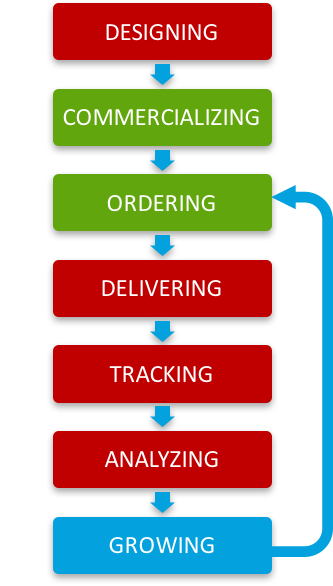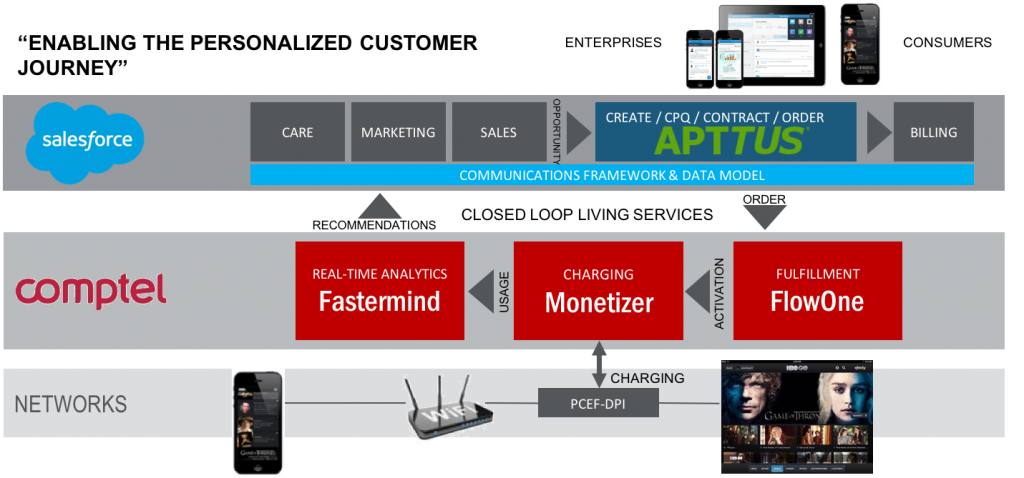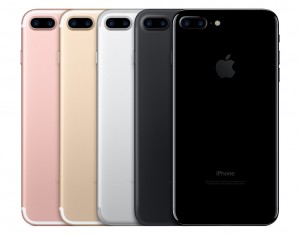Posted: September 28th, 2016 | Author: Steve Hateley | Filed under: Industry Insights | Tags: customer engagement, Generation Cloud, personalized customer journey | Comments Off on Enabling the Personalized Customer Journey
Have the rules changed for Communications Service Providers to engage with their customers?
Digitalization has created a generation of empowered, engaged and demanding “Generation Cloud” consumers. These people want to be treated as individuals through using a service that meets their expectations and aligns to the way they live their lives. They don’t want to follow service providers’ rules but instead, define the digital market as they want to see it. Service providers have to identify product opportunities, then design and commercially publish new service offerings faster than ever. Only then will they be able to seize the increasing new opportunities for data, content, applications and service monetization. Effectively they have to monetize more in less time, whilst leveraging partner offerings for service enrichment.
How do service providers win the hearts and minds of customers with almost impossible expectations?
To meet the expectations of generation cloud consumers it’s no longer sufficient to have a static portfolio of products that a customer selects and uses unchanged for the lifetime of a contract. Lifestyles, demands and expectations create a digital opportunity for providers to continually engage with their customers with contextually relevant enrichments to a base package contract.
These enrichments or upsell opportunities can take the form of traditional data or messaging bundles, however they can now also encompass personalized add-ons such as streaming subscriptions or cloud-storage with a data allowance; time-based video streaming bundles and sponsored enterprise data packages. These modern-day enrichments have to be more understandable by the consumer, as lifestyle enhancements aligned to them.
Service providers have an opportunity to not only create these offerings but intelligently identify when to make a recommendation and with which product. They also have to simplify the engagement and buying process as closed-loop automation, allowing for consistent improvement, alignment and customer retention.
What would the perfect solution look like for CSPs to enable the personalised customer journey?
A comprehensive turnkey solution for the personalized journey will incorporate a number of steps that the customer service lifecycle will take. These steps consist of product creation based on identified market needs, campaign management and commercialization of those products, an ordering process and of course the delivery of a product in the first instance.
Once delivered it’s necessary to collect data and valuable information on the consumed service, which when analyzed provides insights to drive the intelligent recommendations required for next customer contact via a simple interaction or detailed marketing campaign.
Realizing that the recommended add-on is a perfect fit, the consumer then needs a seamless buying and delivery experience – leading to the creation of a revised automation-loop for continuous future engagement.
A Modern Day Customer Engagement Architecture
Leveraging a communications industry data integration framework, Salesforce, Apttus and Comptel are perfecting the personalized customer journey through a number of identifiable steps.
 Designing – B2C or B2B service design based on technical network and service capabilities, with input from market research created by product management.
Designing – B2C or B2B service design based on technical network and service capabilities, with input from market research created by product management.- Commercializing – Publishing of the product as a commercial offering, allowing a customer to discover, select and customize to their needs.
- Ordering – Submission of the selected and customized product as an order into the buying process. Incorporating CPQ processes (Configuration, Pricing and Quotation).
- Delivering – Order processing and service activation plus an all-important notification to the subscriber for full customer engagement into the process.
- Tracking – Continuous charging, metering and full reporting of service consumption by the subscriber, giving a 3600 perspective on contextual usage.
- Analyzing – Contextual analysis on service usage trends of the subscriber leading to intelligent recommendation for product upsell and tailoring – customer alignment and engagement.
- Growing – Perpetual engagement, offering continual recommendations to an individual and the option to buy. Perfecting the customer engagement process.
The Solution
The result is an eco-system primed solution for customer engagement and contextually-intelligent product recommendations, leading to automated customer lifecycle management. The solution is enabled by the Salesforce Communications Framework & Data Exchange, Salesforce Customer Success Platform, Apttus Quote-to-Cash solution and Comptel Intelligent Data Monetization & Customer Engagement Automation.

Posted: September 20th, 2016 | Author: Malla Poikela | Filed under: Events | Tags: Events, Nexterday North, Nexterday Tour | Comments Off on On the Road with The Nexterday Tour 2016
There’s an entire world of fresh ideas and exciting opportunities for telcos to indulge, many of which are discussed in various industry conferences around the world. That’s why Comptel is happy to bring and present these ideas directly to you if you were not able to hop on a plane and visit each event. 
The Nexterday Tour 2016 is our global effort to share the latest, most dominant and most appealing market trends directly with our customers and partners. At the same time, we discuss key thought leadership themes, including how Comptel’s software addresses market requirements in Nexterday.
We want to tap into the latest industry trends and insights from major global industry events, including our own Nexterday North event, which asks telcos to stop thinking about digital transformation and start executing. We package everything together with content and videos from operators, industry speakers and thought leaders, and go on tour to deliver them to telcos around the world.
What is the Nexterday Tour?
The program includes trends and insights gathered from a number of big events, stretching from the Comptel anti-seminar Nexterday North in Helsinki last November, and extending through Mobile World Congress in Barcelona, TM Forum Live! in Nice, the Big Communications Event in Austin, and a scattering of NFV/SDN events throughout Europe and the U.S. Our next stop will be in October for Dreamforce in San Francisco and the SDN and OpenFlow World Congress in The Hague.
It’s the third consecutive year we’ve run a global program. You might have known our previous tours by other names – “Barcelona in a Box” in 2014 and “Beyond the Event Horizon” last year. We visited more than 15 cities last year, meeting with 400 individual customers from 45 global operators.
So far, this year’s tour has taken us to South America, Europe and the Asia Pacific region, adding up to over 10 countries, over 15 cities, dozens of operator brands and hundreds of individual customers. And the tour finishes with our second annual Nexterday North from 28-29 November, 2016 in Helsinki.
Top Themes for 2016
Our focus in 2016 is on digital transformation and disruption within the telco industry.
We wanted to cover how new players in telco – including startups, but also non-telco players like Airbnb, Uber and Spotify – are shaking up the industry with innovative digital offerings that require operators to change their approach.
We’re also covering broader global trends. In his keynote speech at Nexterday North 2015, Kjell Nordstrom talked about urbanisation, describing how within the next 20 to 30 years, 80 percent of the world’s population and 90 percent of its economic value will be centralised in 600 megacities. On the tour, we’ve discussed what that means for telcos in the years ahead.
Similarly, we’ve heard frequently about the increasing value placed on customer experiences. A massive 89 percent of companies planned to compete on the basis of customer experience this year, according to Gartner. How has digitalisation influenced that trend, and – as keynote speaker Mike Walsh will discuss at Nexterday North 2016 – how does the increasing level of consumer familiarity with digital tools and services impact telco innovation?
We’ve discussed new telco business models, new network technologies and new service opportunities. We know that networks are embracing software in the era of NFV, data centres and cloud. We know that the Internet of Things (IoT) is a major opportunity, but that 99 percent of devices aren’t connected to the internet yet. At the same time, we know that up to four billion people on Earth also lack internet access. So what are operators and the whole industry doing to solve that challenge, alongside the others?
We’re also covering a number of challenges and opportunities in our industry, such as the need to find fresh new data monetisation strategies to take advantage of customers’ hunger for digital services. We also discuss the increased need for hyper personalisation in marketing, sales and service, and the need for telcos to re-engineer their service orchestration models to suit a more self-serve, conversational and automated service delivery lifecycle.
It’s been exciting to get out of the office, speak directly with customers and hear their ideas and thoughts on all of these concepts. Generally speaking, we’re seeing operators starting to broaden their mode of thinking. Ideas that would have once been considered too radical for telco are now being carefully considered, whether it’s ways to change how we work, new service opportunities to tap into, or new global trends that affect our business.
It’s important for telcos to continue the conversation and step away from the industry’s collective blindspot. With the Nexterday Tour 2016, Comptel is proud to play a part in helping operators have these important discussions.
Join us on the Nexterday Tour 2016 by registering for Nexterday North 2016, 28-29 November, in Helsinki. You can check out our fantastic speaker lineup here, which to date includes digital transformation visionary Mike Walsh, marketing guru David Meerman Scott, futurologist Dietmar Dahmen, operator speakers and many more.
Posted: September 13th, 2016 | Author: Steve Hateley | Filed under: Industry Insights | Tags: OSS, OSS/BSS, SDN & OpenFlow World, service orchestration | Comments Off on Forget the iPhone. The Next Great UI Design Change is in OSS
Have you preordered your new iPhone 7? Or were you, like many observers, underwhelmed with Apple’s latest product launch?
The tech leader rolled out the newest version of its smartphone last week, and by all accounts the latest iPhone’s features are mostly iterative than innovative. The most disruptive hardware change was also the one that frustrated consumers the most: the elimination of the 3.5 mm headphone jack, which requires iPhone users to use Apple’s proprietary headphones instead. 
Similarly, the iPhone’s user interface seems to have plateaued. While the iPhone 7 will ship with a new operating system that includes a handful of new features, the look and feel of Apple’s UI is still virtually unchanged from where it was several generations ago. You can add some more pixels here and round off a few bevels there, but for the most part, iOS doesn’t offer much opportunity for further design innovation. Apple’s UI is what it is because that’s what its devout customers expect.
That’s not necessarily a knock against Apple’s UI. They’ve found an interface that suits its fanbase, and they’ve even inspired design innovation in other areas of software development. In fact, one software experience that’s long overdue for a fresh coat of paint and user-friendly functionality is OSS.
To date, we’ve seen OSS interfaces designed around the technology in the network: topologies, hardware representations and configurations that must be manually realigned based on user. However, the emerging app- and data-driven digital economy is putting increased pressure on operator networks to be agile, dynamic and automated. Meanwhile network function virtualisation (NFV) is changing the speed and nature of service orchestration by simplifying network processes and application deployment.
Doesn’t it make sense, then, that the OSS should be refreshed to enable an agile and more productive work experience for telco operations managers?
Telco is starved for a strong, functional and distinct OSS UI. The folks who support service orchestration vary in roles, responsibilities, skill levels and professional backgrounds. OSS UIs should be designed to correspond to that variety, so that each user is able to focus only on those operational elements that they are most equipped to manage. That increases efficiency and the speed at which digital services can be developed, verified, deployed and improved.
As a result, time-to-profit goes down, while customer satisfaction goes up.
That’s why the shift toward cloud-service operational management will bring an evolution to the OSS, in the form of tailored, intuitive user experiences and subsequently increased productivity. The new OSS will be open, capable of seamlessly interacting with both telco and IT apps and their corresponding management systems. As a result, telcos benefit from a higher order platform to specify, test, publish for consumption and deliver services across virtual, physical and IT domains.
An intuitive OSS UI also supports a seamless end-to-end service lifecycle, eliminating any gaps in the process by which network resources are discovered and services are designed and deployed.
Ultimately, the new OSS recognises that virtualisation is an opportunity for telco to reinvent itself. Operators can offer more than just a telecommunications platform – they have a chance to become part of a larger, distributed IT infrastructure that seamlessly provides services to end customers. Our existing OSS culture needs to evolve in order to recognise that this paradigm shift requires opening up the infrastructure to deliver services and resources in a more agile, open and systematic way.
Comptel will discuss the reinvention of the OSS user interface paradigm in The Hague for SDN & OpenFlow World Congress, 10-14 October 2016. Contact [email protected] to connect with our team or arrange a meeting at the event.
Posted: September 12th, 2016 | Author: Steve Hateley | Filed under: Industry Insights | Comments Off on Comptel and MEF: Shaping Service Orchestration for the Digital Economy
For the past 15 years, the MEF Forum has been focused on driving forward innovations in network performance to help operators deliver carrier-grade ethernet connectivity and more recently, what it calls “Third Network Services.” As one of 200 member organisations, Comptel is pleased to play an important role helping to shape MEF’s guidance around next-generation service orchestration with our Digital Service Lifecycle Management (DSLM) model.
Last month, Comptel took part in the primary annual meeting of the MEF member organisation in Boston, where we had a great opportunity to explore how our DSLM model for service orchestration complements MEF’s vision for NFV-driven service delivery and lifecycle management.
What are Third Network Services?
MEF describes Third Network Services as those that “combine the on-demand agility and ubiquity of the Internet with the performance and security assurances of Carrier Ethernet 2.0.” The organisation is essentially describing a variety of digital services that rely on optimised high-performance networks to meet the quality of service expectations of today’s digitally savvy Generation Cloud consumers.
Examples include performance-assured wired or wireless internet connectivity, which automatically optimises the performance of your network whether you’re working on a train, in your home or from a hotel room on a business trip. The Third Network also provides assured, dynamic network performance for businesses, enhancing the experience for each end user on each cloud application even if the company uses multiple internet providers across multiple offices.
The idea is to provide quality, assured service experiences that customers can control. MEF’s vision for Third Network Services closely aligns with Comptel’s own view of dynamic digital services, which is why we’re excited to bring our DSLM model to the table in conversations with MEF member organisations.
Developing LSO and DSLM
To enable these services, MEF has introduced a number of models and specifications that define how operators should evolve their networks and integrate emerging technologies, such as network functions virtualisation (NFV). Member organisations, like Comptel, take part in ongoing MEF initiatives and proofs of concept to engage with and develop these standards and models.
One such model is MEF’s Lifecycle Service Orchestration (LSO), which leans on NFV and software-defined networks (SDN) to streamline and automate “the service lifecycle in a sustainable fashion for coordinated management and control across all network domains responsible for delivering an end-to-end connectivity service,” according to MEF.
Comptel’s DLSM, which models dynamic service orchestration in an NFV-driven digital economy, complements LSO nicely. It’s a three-tiered conversational architecture in which:
- A customer-facing top layer handles order capture, configuration and invoicing
- A middle digital service lifecycle management layer offers dynamic service design, orchestration, assurance and delivery
- A bottom layer handles resource management with physical and virtual systems.
The parallel concepts of LSO and DLSM both recognise the important role virtual functions will play in the development of operator networks and the delivery of dynamic, high-performance digital services to consumers.
Comptel is eager to be part of the conversation within MEF to help define how LSO standards evolve, and we believe our ongoing involvement with MEF will help us bring a higher level of expertise to conversations with our own customers around NFV-driven service orchestration.
Learn more about DSLM in our whitepaper “Digital Service Lifecycle Management: How Communications Service Providers Can Play a Successful Role in the Digital Economy”
Comptel will be showcasing and discussing the Digital Service Lifecycle Management including their FlowOne V solution for end-to-end hybrid network service orchestration at a number of events in the coming weeks.
To connect with our team or set up a meeting, email [email protected].
 Designing – B2C or B2B service design based on technical network and service capabilities, with input from market research created by product management.
Designing – B2C or B2B service design based on technical network and service capabilities, with input from market research created by product management.








